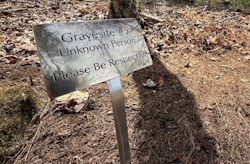Story by Debra Anderson
In 1860, more than 550,000 enslaved Black people lived in Virginia, accounting for one-third of the state’s population. In the rural village of Montebello, historical records confirm that several families owned enslaved individuals. Life expectancy for those in servitude was about 36 years, and infant and child mortality rates were tragically high. Forced to labor six days a week, many also endured legal prohibitions. By the 1830s, it was illegal in Virginia for enslaved persons to read or write.
 On April 29, 2025, members of the Montebello community, representatives of the Potomac Conference Corporation, and Camp Blue Ridge (CBR) staff gathered to remember the lives of enslaved and Indigenous people who once lived, worked and died on the land where the camp now sits. Though history has not preserved their names, their presence remains deeply rooted in the place they once called home. At least five burial sites have been identified on the property. The unmarked graves have no headstones and no recorded identities. Their legacy serves as a quiet testimony to their daily struggles of survival and perseverance.
On April 29, 2025, members of the Montebello community, representatives of the Potomac Conference Corporation, and Camp Blue Ridge (CBR) staff gathered to remember the lives of enslaved and Indigenous people who once lived, worked and died on the land where the camp now sits. Though history has not preserved their names, their presence remains deeply rooted in the place they once called home. At least five burial sites have been identified on the property. The unmarked graves have no headstones and no recorded identities. Their legacy serves as a quiet testimony to their daily struggles of survival and perseverance.
The effort to confirm these graves began with camp leadership. CBR Director Ray Queen and Assistant Director Julie Minnick had heard longstanding local accounts about unmarked graves on the property. They invited Lynn Caldwell, a dedicated camp volunteer, to research the folklore.
Caldwell approached the mission with care, concern and conviction. She spoke with longtime residents, studied historical archives and brought in cadaver dogs to survey the area. In 2024, the dogs confirmed what oral tradition had long suggested: The presence of multiple burial sites belonging to enslaved and Indigenous individuals. Many of these people were likely laid to rest without markers, reflecting a historical pattern in which burial practices for the enslaved lacked dignity, documentation and permanence. According to historical records, when an enslaved person died, the day’s work would be completed before the body was prepared for burial; hence, most funerals were held at night. Indigenous burial grounds, too, were frequently desecrated or ignored.
“Through this research, we have uncovered more than just burial sites; we have uncovered a call to remember,” Caldwell says. “We must do better to honor each other with love, respect and equality. We are all equal in the sight of God.”
At the dedication ceremony, Potomac Conference President Charles A.Tapp delivered a brief homily, emphasizing the spiritual and moral importance of remembering. “History is important because people are important,” he said. “Though we may not know their names, God does. If people are important to God, regardless of their station in life, then they must also be important to us.”
Now, with renewed understanding, CBR stands not only as a place of recreation and retreat but a sacred site for those forgotten in death.

